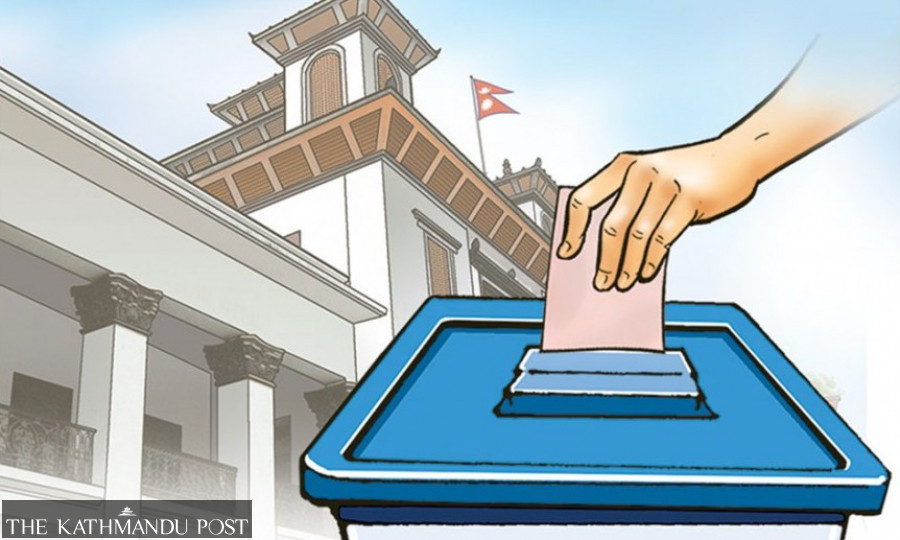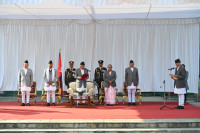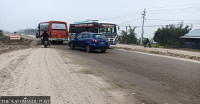National
Experts warn against hasty change in electoral system
As two major parties peddle the narrative of a flawed system that elects hung parliament, direct election is no panacea, observers say.
Binod Ghimire
The calls to amend the Constitution of Nepal to revisit the current electoral system have been growing over the months. It formally started with the Nepali Congress Central Working Committee meeting in July last year. Over a dozen Congress central members advocated electing all members of the lower house through a first-past-the-post (FPTP) model by changing the mixed system that is currently in practice.
The largest party that is internally divided on several issues seems to have a consensus view when it comes to changing the electoral system. Though the agenda formally entered discussion in the party committee thanks to its chief whip Ramesh Lekhak, who is close to Sher Bahadur Deuba, the party president, Shekhar Koirala, a leader of the dissident faction in the Congress, has emerged as a true advocate of the agenda.
On several forums, Koirala has claimed that revision of the mixed electoral system is necessary for the country’s stability. Over the months, those from outside the Congress also have started advocating a directly elected lower house arguing that no party can secure a majority under the existing system, thus perpetuating political instability in the country.
Not only leaders from political parties but also the head of the House of Representatives recently echoed them.
“It is necessary to revise the electoral system for stability. No party can get majority seats under the present system, which means instability will continue to prevail,” said Devraj Ghimire, Speaker of the House of Representatives, at a programme on March 27.
The leaders from the CPN-UML have expressed similar views.
“Though the issue hasn’t entered as a formal agenda in our party meetings, discontent over the present electoral system is growing,” Mahesh Bartaula, the party’s chief whip, told the Post. “Adopting direct election is necessary to put an end to unnecessary bargaining of the parties with even two or three seats.”
In the 275-member lower house, 60 percent (165) members are elected directly from the constituencies while the remaining 40 percent (110) are elected under the proportional representation system, as per Article 84 of the Constitution of Nepal. The country adopted direct elections of lower house members until the Interim Constitution was put into force in 2007. Following strong opposition from the Maoist party and other regional forces, a mixed electoral system was adopted.
As many as 60 percent of the members of the first and the second Constituent Assembly were nominated for proportional representation while 4o percent were directly elected. But the shares of the two types of representation were reversed while adopting the new constitution through the Constituent Assembly.
A mixed model was adopted to ensure that the proportional representation model will compensate for the lack of needed representation from a particular group or community through direct election. For instance, the constitution envisions at least 33 percent representation in the lower house. But when the representation is not met through direct election, the proportional category compensates for it.
Some legal experts fear representation of various marginalised groups might be severely curtailed with the change in the electoral system.
“The present system was adopted to ensure the representation of the marginalised and disadvantaged communities. The question is, how their representation will be ensured in the new system,” advocate Mohna Ansari, a former member of the National Human Rights Commission, told the Post. “To me, replacing the existing system with the FPTP sounds like a regressive move.”
The political parties argue that there are several ways representation of different groups can be ensured under the direct electoral system. Making the National Assembly fully proportional and reserving some seats for people from particular communities are some ideas they have floated.
Talking to the Post after the party’s Mahasamti meeting in February last week, Min Bishwakarma, the chief of the Congress publicity department, had claimed that there are several ways to make the FPTP representative.
But constitutional experts aren’t convinced.
“Yes, even the FPTP can be representative but I doubt these parties mean well when they say they want direct elections,” senior advocate Bipin Adhikari, a professor at the Kathmandu University School of Law, told the Post. “If people in power are vile, no system works properly.”
Adhikari says the electoral system can be reformed if there is the need and political consensus but the pitfalls of changes must be properly evaluated.
“Amending the constitution at this point is like opening the Pandora’s box. It may plunge the country into another episode of instability. I don’t see the parties having political legitimacy or power to control that,” he said.
Nepal has held seven general elections ever since the restoration of democracy in 1990. The Nepali Congress got majority in the two elections held in 1991 and 1999 but even that couldn’t ensure stability because of factional disputes within the party. Some experts say when parties lack the right political culture, no electorate can ensure stability.
Senior advocate Purna Man Shakya, professor at Nepal Law Campus, says he opposes the idea of a change in the electoral system of the federal level. He, however, is for adopting a presidential system of election at the provincial level.
“Dirty politics has limited the roles of the provincial assemblies to making and unmaking a government. I am for directly elected chief minister at the provincial level for greater stability,” he told the Post. “If that works, we might think of replicating it at the federal level. But it won’t be right to change the electoral system at the centre at this point.”




 12.12°C Kathmandu
12.12°C Kathmandu















